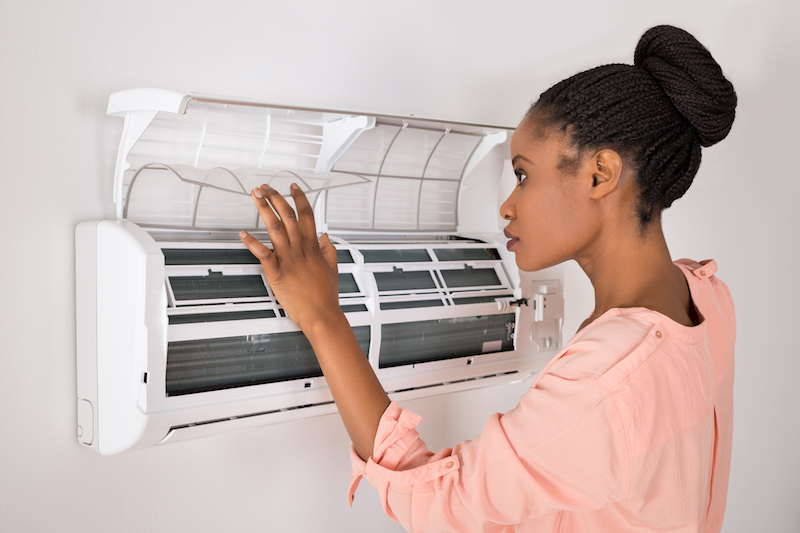
You shouldn’t be forced to compromise on comfort or empty your wallet to keep your house at the right temperature during hot days.
But what is the ideal temperature, exactly? We discuss recommendations from energy experts so you can select the best temp for your family.
Here’s what we suggest for the most energy-efficient setting for air conditioning in Derby.
Recommended Thermostat Settings for Summer
Most families find using the thermostat at 72-73 degrees is most comfortable. However, if there’s a major difference between your interior and outdoor temperatures, your electricity expenses will be greater.
This is our advice based on the U.S. Department of Energy (DOE) and ENERGY STAR®.
While at home: 78 degrees. While that seems warm, there are methods you can keep your residence cool without having the air conditioner going frequently.
Keeping windows and window treatments closed during the day keeps cold air where it belongs—indoors. Some window solutions, including honeycomb shades or plantation shutters, are designed to deliver added insulation and improved energy savings.
If you have ceiling fans in your residence, the DOE says you can raise thermostat temps about 4 degrees higher without compromising comfort. That’s because they refresh with a windchill effect. Because they cool people, not areas, switch them off when you move from a room.
If 78 degrees still appears too hot on the surface, try running a test for approximately a week. Start by raising your temperature to 78 degrees while you’re home. Then, gradually turn it down while following the advice above. You might be astonished at how refreshed you feel at a warmer temperature setting.
While away: 88 degrees. There’s no need to keep the air conditioner running all day while your residence is unoccupied. Switching the temperature 7–10 degrees hotter can save you an estimated 5–15% on your cooling costs, according to the DOE.
When you arrive home, don’t be tempted to put your thermostat colder than 78 to cool your home faster. This isn’t productive and typically produces a higher AC expense.
A programmable thermostat is a useful method to keep your temp in check, but you have to set programs. If you don’t utilize programs, you run the risk of forgetting to raise the set temperature when you go.
If you’re looking for a hassle-free fix, think over getting a smart thermostat. This thermostat connects with your phone, so it realizes when you’re at your residence and when you’re gone. Then it automatically adjusts temperature settings for the biggest savings. How much exactly? About $180 annually on heating and cooling, according to ENERGY STAR.
Another plus of installing a smart thermostat? You can use your phone to keep an eye on and change temperature settings from nearly anywhere.
While sleeping: Around 70 degrees. While ENERGY STAR suggests 82 degrees, that might be too uncomfortable for the majority of families. Many people sleep better when their sleeping space is cold, so that’s why the National Sleep Foundation suggests 60–67 degrees. But that might be too chilly, depending on your PJ and blanket preference.
We suggest using an equivalent test over a week, setting your temp higher and slowly turning it down to choose the right temperature for your residence. On pleasant nights, you could discover keeping windows open at night and using a ceiling fan is a better solution than using the air conditioning.
More Ways to Use Less Energy During Warm Weather
There are additional ways you can spend less money on AC bills throughout hot weather.
- Install an energy-efficient cooling system. Central air conditioners only are effective for about 12–15 years and get less efficient as they get older. An updated air conditioner can keep your house more comfortable while keeping utility bills small.
- Schedule regular air conditioner tune-ups. Routine air conditioner maintenance keeps your unit operating properly and could help it run at better efficiency. It might also help extend its life expectancy, since it allows technicians to pinpoint little problems before they lead to a major meltdown.
- Put in new air filters regularly. Use manufacturer instructions for replacing your air filter. A dusty filter can result in your system short cycling, or turn on and off too often, and increase your electricity.
- Inspect attic insulation levels. Nearly 90% of residences in the USA don’t have adequate insulation, according to the Insulation Institute. Many southern climates require 13–14” of attic insulation, while northern climates need 16–18”.
- Have your ductwork checked. Ductwork that has come apart over time can seep cool air into your attic, walls or crawl space. This can create major comfort issues in your residence, like hot and cold spots.
- Seal cracks, doors and windows. Keep muggy air where it should be by closing openings. You can also caulk or weather strip doors to trap more conditioned air within your home.
Conserve More Energy This Summer with Giordanos Heating and Air Conditioning
If you want to save more energy this summer, our Giordanos Heating and Air Conditioning specialists can assist you. Reach us at 203-941-5099 or contact us online for extra details about our energy-saving cooling products.
